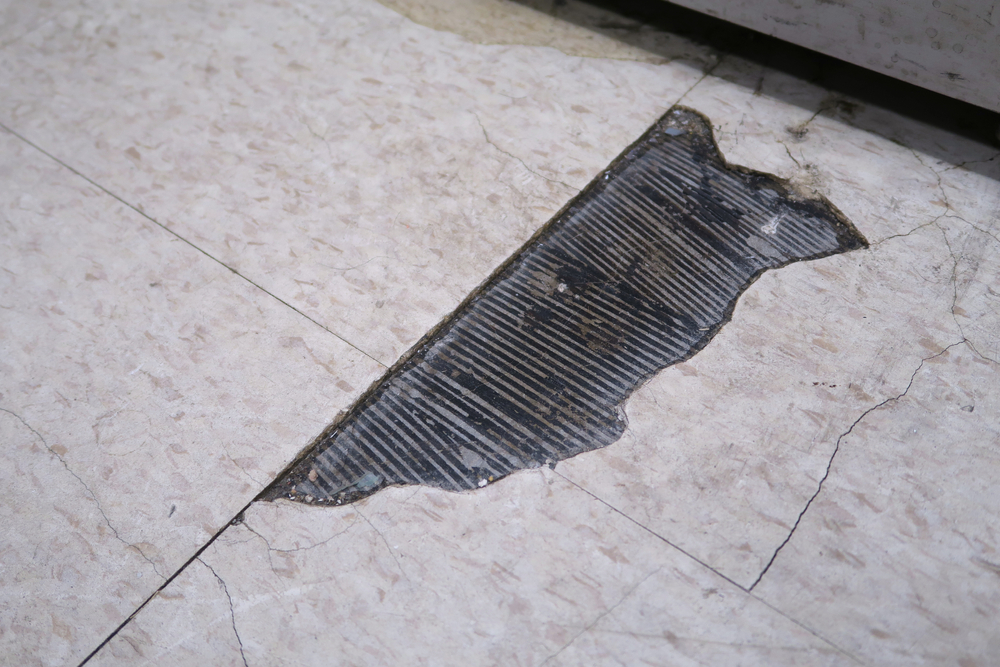Linoleum, vinyl, asphalt, and vinyl tile flooring have been installed in homes, businesses, military installations, and even aboard ships for more than a century. The inexpensive materials were perfect for high-traffic areas, as they were both attractive and durable, but until the 1980s, they often contained asbestos. People exposed to these contaminated products while installing or removing them are at risk for mesothelioma and other asbestos-related diseases.

When Was Asbestos Used in Flooring?
Linoleum, asphalt, and vinyl flooring are often found in older homes and are thought of as similar products. They have different histories and years of popularity and present different risks of asbestos exposure.
Linoleum was first invented in the late 19th century and is a natural material. It is made of a combination of wood flour, linseed oil, limestone, and other mineral fillers, jute, pine rosin, and natural pigments.
Asphalt flooring, which contained asbestos as a filler, was introduced in the 1920s and manufactured in sheets and tiles. It began replacing linoleum, especially for use on concrete floors below grade.
Polyvinyl chloride, or vinyl, replaced asphalt in the 1950s. Vinyl is similarly durable and flexible. Vinyl is made from chlorinated petrochemicals, is brighter, more translucent, and easier to maintain.[1]
Most people have a hard time distinguishing between the different materials, but there are a few clues:
- Because linoleum’s patterns and colors extend to the backing, where vinyl patterns are stamped on it, if a pattern has worn away, the flooring is made of vinyl.
- Similarly, if the flooring is original and a building was constructed before World War II, it must be linoleum, as vinyl flooring was not invented until the 1950s.
- Finally, only linoleum has a canvas backing.[1]
Both linoleum and vinyl flooring, as well as vinyl tiles, contained asbestos until the 1980s, when the material’s toxicity became public knowledge. The carcinogenic material was added to both to provide additional strength, durability, and fire resistance.
What Flooring Products Contained Asbestos?
Up until the 1980s, asbestos was commonly found in vinyl tiles and linoleum. It was also in the felt-like backing that was used to provide a cushion under the flooring’s surface and the adhesive used to affix it to the floor.
- Linoleum. While the original linoleum product did not contain asbestos, many other manufacturers producing their own version of the sheet flooring used backing materials that included asphalt-impregnated felt paper that contained asbestos. These products first began appearing in the United States in 1910 and were expanded when Armstrong Cork Industries began producing its version of linoleum, known as Linoflor, in 1937. This product, and others that followed, were less expensive to produce than true linoleum but are generally thought of as linoleum products. Asbestos may also have been contained in the black mastic flooring adhesive used to affix the product to the floors.[2]
- Asphalt. Asphalt flooring contained as much as 70% asbestos by weight as a mineral filler. It was generally used between the 1920s and 1960s. Tiles were 9” x 9” and 12” x 12” and typically produced in dark colors because their main binder was asphalt. It was recommended for use on concrete floors below grade because it was not susceptible to deterioration from alkali leaching out of the material. It was also resistant to fire and rot, but was noisier to install and easier to damage.[3]
- Vinyl tile. Vinyl tiles were most popular between the 1950s and 1970s. Because it used resin vinyl as its binder, lighter colors could be produced, and large amounts of chrysotile asbestos were added to the resin to improve mechanical, heat, and corrosion resistance. These tiles were available in 9” x 9” sizes and 12” x 12” sizes.
- Vinyl sheet flooring. Like linoleum, vinyl sheet flooring rarely contained asbestos, but the backing material that it was installed with contained asbestos.
- Floor backing. Manufacturers of vinyl sheet flooring and companies making their own version of linoleum often incorporated a felt-like backing for cushioning purposes. This backing typically contained 80-100 percent asbestos.[4]
- Flooring adhesives. Adhesives used to install flooring frequently contained significant amounts of asbestos. The product that was used most frequently was called black mastic.
Companies that Manufactured Asbestos Flooring Products
Several well-known companies manufactured and sold asbestos flooring products. These companies have frequently been named as defendants in mesothelioma personal injury lawsuits and other asbestos-related claims.
Several flooring companies have been forced into bankruptcy by their asbestos liabilities and required to establish asbestos trust funds for the benefit of victims of their negligence.
Companies that made flooring products with asbestos include:
- American Biltrite
- American Olean
- Amtico Floors
- Armstrong World Industries
- Congoleum Corporation
- Eternit Corporation
- EverWear
- Fashionflor
- Flintkote Company
- GAF Corporation
- Gold Seal
- Goodyear
- Kentile Floors
- Manning Mills Flooring
- Matico Flooring
- Montgomery Ward
- National Gypsum
- Nicolet, Inc.
- Owens Corning Corporation
- Pebco Floron Flooring
- Philip Carey Asbestos Products
- Sears & Roebuck
- Solarian
Who Was at Risk of Exposure to Asbestos in Flooring Products?
Occupational asbestos exposure is the leading cause of asbestos-related diseases. Asbestos in flooring can also impact homeowners who do their own repairs, renovations, and remodeling.
Also affected are family members who are exposed to the deadly fiber carried home on their family members’ hair, skin, or clothing. This is called secondary asbestos exposure.
Also at risk are those who work or live in buildings where asbestos-containing flooring has been in place for years, including hospitals, school buildings, administrative buildings, and military facilities.
While exposure to asbestos in modern-day products is no longer a risk, many occupations continue to be at risk of what is known as the third wave of asbestos exposure: This is caused by working in environments where asbestos-contaminated products installed long ago, also known as legacy asbestos, need to be removed.
Workers who were put at risk of disease by asbestos flooring products came into contact with the products in numerous ways. These included floor installations and removals and maintenance, which generally included working directly with flooring felt, cutting or bending the tiles, sanding them, or scraping away the adhesive.
People who were nearby were also at risk of bystander exposure from asbestos that became airborne during these processes.
Those people most at risk to exposure to asbetos in flooring include:
- Air Force veterans
- Army veterans
- Carpenters
- Coast Guard veterans
- Construction workers
- Demolition crews
- Flooring installers
- Handymen
- Maintenance workers
- Marine veterans
- Navy veterans
- Vinyl factory workers
Lawsuits Filed by People Sickened by Asbestos in Flooring
There have been thousands of victims of exposure to asbestos contained in flooring, and many of them have filed personal injury lawsuits against the companies responsible for their exposure. Some notable examples have included:
- Victoria Pistone was diagnosed with peritoneal mesothelioma at the age of 41 and blamed her disease on exposure to asbestos in floor tiles that her father worked with at his job at Mannington Mills and American Biltrite. Her claim noted that she would go to work with him on Saturdays and sit nearby as he cut vinyl sheet flooring and opened boxes of tile. She also referenced the asbestos that covered his work clothes each night when he came home.
- Santo Lanza’s son filed a wrongful death lawsuit against American Biltrite following his father’s death from malignant mesothelioma. He claimed that the man had used the asbestos-containing tiles during home renovations between 1963 and the early 1980s, as well as during side jobs he did throughout New York and New Jersey between 1966 and 1973.
Protecting Yourself Against Exposure to Asbestos in Flooring
Whether you are a professional contractor who encounters asbestos flooring on the job or a homeowner about to start a do-it-yourself project, it’s important to understand that any vinyl, asphalt, or linoleum-type flooring that was installed before the mid-1980s may contain asbestos.
It’s important that you take steps to protect yourself. Below, you’ll find guidance on removing both vinyl asbestos floor tiles and sheet vinyl flooring.
- Vinyl asbestos floor tiles that have not been damaged are considered non-friable. They do not pose a risk as long as they are in good condition. If you encounter asbestos floor tiles that have been cut or damaged in any way, the asbestos in them is friable and can be inhaled, and should only be handled by an asbestos abatement professional.[5]
- The goal in removing nonfriable asbestos floor tiles is for them to remain intact. Tools to accomplish this include a water sprayer, three- to six-mil thick plastic sheeting, and wide putty knives, a paint scraper, or a flat floor scraper. The sheeting should be used to isolate doorways and cover floor registers and vents to prevent contamination. The tiles should be kept wet during removal, as well as while being packaged and disposed of, to minimize the risk of asbestos fibers being released. Use a wide putty knife or flat floor scraper to gently pry up the tiles in whole pieces. Do not break them or step on them. If the material cannot be removed without breaking, contact a professional for assistance. Disposal should be done using thick plastic bags or similar leak-tight packaging marked with an asbestos hazard label and must only be disposed of at a landfill permitted to accept asbestos waste.[5]
- Sheet vinyl flooring with asbestos backing should only be removed by a homeowner if the backing can be peeled off without disturbing the asbestos-containing material or if the vinyl was laid over plywood or particle board and can be removed with the underlayment still attached. If that is not the case, an asbestos abatement professional must be called. Otherwise, removal should begin with wearing an appropriate respirator and protective clothing. The material must be thoroughly saturated with water that’s been mixed with liquid dishwashing detergent to keep asbestos fibers out of the air and kept wet until packaged and sealed for disposal. Plastic sheeting should be used to contain the asbestos and prevent it from spreading beyond the project site.[6]
The material should be either peeled off the vinyl sheeting or removed in sections. To do this, use a marking pen to outline a section, then cut pieces using either a utility knife or a hammer and chisel to make consecutive vertical cuts.
The area should be sprayed following each cut to wet exposed asbestos edges, and the pieces should immediately be placed into sealed containers for disposal. The area should be carefully sprayed down and cleaned after the procedure.[6]
Were You Diagnosed with Mesothelioma After Exposure to Asbestos-Containing Flooring?
If you’ve been exposed to asbestos-containing flooring and diagnosed with mesothelioma or another asbestos-related disease, a mesothelioma lawyer will be an invaluable guide as you consider whether to pursue compensation from those responsible.
There are several options available, including filing a claim with an asbestos trust fund if the company responsible for your exposure has filed for bankruptcy or filing a personal injury lawsuit.
References
- Gromicko, N. (n.d.). Linoleum Inspection. International Association of Certified Home Inspectors.
Retrieved from: https://www.nachi.org/linoleum-inspection.htm - Inspectapedia. (n.d.). Asbestos in Linoleum Flooring Materials.
Retrieved from: https://inspectapedia.com/interiors/Linoleum-Asbestos-Content.php - Smith, B. (n.d.). The Original Vinyl Composition Tile (VCT) – Asphalt & Asbestos Tile Flooring. Waxie Sanitary Supply.
Retrieved from: https://info.waxie.com/blog/the-original-vinyl-composition-tile-vct-asphalt-asbestos-tile-flooring - Workplace Health and Safety Queensland. (2011, December). Asbestos Flooring.
Retrieved from: https://www.asbestos.qld.gov.au/sites/default/files/asbestos-flooring.pdf?v=1553738546 - State of Oregon Department of Environmental Quality. (n.d.). Asbestos Program Guidance. How to Remove Nonfriable Vinyl Asbestos Floor Tiles.
Retrieved from: https://www.oregon.gov/deq/Hazards-and-Cleanup/Documents/NonfriableVAFT.pdf - Southwest Clean Air Agency. (n.d.). Asbestos Removal Procedures for Homeowners.
Retrieved from: https://www.swcleanair.gov/docs/misc/asbestos_flooring.pdf

Terri Heimann Oppenheimer
WriterTerri Oppenheimer has been writing about mesothelioma and asbestos topics for over ten years. She has a degree in English from the College of William and Mary. Terri’s experience as the head writer of our Mesothelioma.net news blog gives her a wealth of knowledge which she brings to all Mesothelioma.net articles she authors.

Dave Foster
Page EditorDave has been a mesothelioma Patient Advocate for over 10 years. He consistently attends all major national and international mesothelioma meetings. In doing so, he is able to stay on top of the latest treatments, clinical trials, and research results. He also personally meets with mesothelioma patients and their families and connects them with the best medical specialists and legal representatives available.


